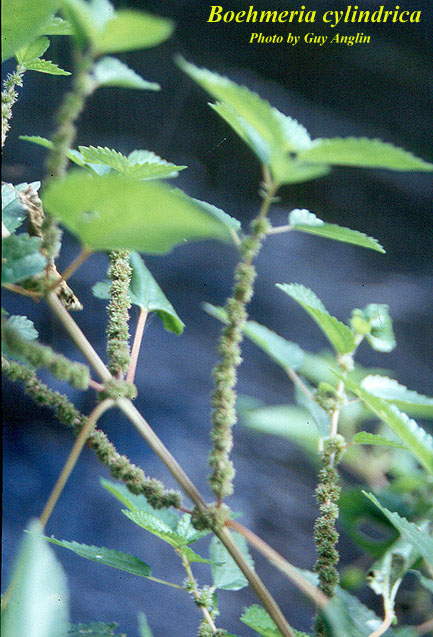Difference between revisions of "Boehmeria cylindrica"
(→Taxonomic Notes) |
|||
| Line 21: | Line 21: | ||
Synonyms: none<ref name=weakley/> | Synonyms: none<ref name=weakley/> | ||
| − | Varieties: ''Boehmeria cylindrica'' var. ''drummondiana'' (Weddell) Weddell; ''B. decurrens'' Small; ''B. drummondiana'' Weddell<ref name=weakley/> | + | Varieties: ''Boehmeria cylindrica'' (Linnaeus) Swartz; ''Boehmeria cylindrica'' var. ''drummondiana'' (Weddell) Weddell; ''B. decurrens'' Small; ''B. drummondiana'' Weddell<ref name=weakley/> |
==Description== | ==Description== | ||
Latest revision as of 12:35, 13 July 2023
Common name: false-nettle [1], smallspike false nettle [2]
| Boehmeria cylindrica | |
|---|---|

| |
| Photo by the Atlas of Florida Plants Database | |
| Scientific classification | |
| Kingdom: | Plantae |
| Division: | Magnoliophyta - Flowering plants |
| Class: | Magnoliopsida - Dicots |
| Order: | Urticales |
| Family: | Urticaceae |
| Genus: | Boehmeria |
| Species: | B. cylindrica |
| Binomial name | |
| Boehmeria cylindrica (L) | |

| |
| Natural range of Boehmeria cylindrica from USDA NRCS Plants Database. | |
Contents
Taxonomic Notes
Synonyms: none[1]
Varieties: Boehmeria cylindrica (Linnaeus) Swartz; Boehmeria cylindrica var. drummondiana (Weddell) Weddell; B. decurrens Small; B. drummondiana Weddell[1]
Description
B. cylindrica is a perennial forb/herb of the Urticaceae family native to North America, Canada, and Puerto Rico.[2] It has tiny green flowers that are in small head-like clusters arranged in interrupted or continuous spikes in the axils of opposite leaves. The leaf arrangement is simple, and plant lacks the stinging hairs found in other members of the nettle family.[3]
Distribution
B. cylindrica is found in Puerto Rico, the Quebec and Ontario regions of Canada, and everywhere but the northwestern corner of the United States. [2]
Ecology
Habitat
B. cylindrica is found in swamp forests, bottomlands, bogs, tidal marshes, and other marshes and wetlands.[4][5]
Associated species: Rhynchospora sp., Mikania sp., Polygonum sp., Salix humilis, Erianthus sp., Smilax laurifolia, Rubus cuneifolius, Rubus trivialis, Pedicularis sp., Nyssa aquatica, Taxodium distichum, Fraxinus profunda, and Arisaema sp.[5][6]
Phenology
B. cylindrica has been observed flowering between August and September. [7]
Seed bank and germination
It has a low relative density in the seed bank where it is found.[8]
Fire ecology
B. cylindrica is not fire resistant, but does have a medium fire tolerance. [2]
Herbivory and toxicology
B. cylindrica is somewhat palatable to grazing animals.[2] It also attracts butterflies for pollination, and is a larval host for the eastern comma (Polygonia comma) and the red admiral (Vanessa atalanta).[3]
Diseases and parasites
It is a host plant for the false spider mite (Brevipalpus californicus) in North America.[9]
Conservation, cultivation, and restoration
Cultural use
Photo Gallery
References and notes
- ↑ 1.0 1.1 1.2 Weakley, A.S. 2020. Flora of the Southeastern United States. Edition of 20 October 2020. University of North Carolina at Chapel Hill, Chapel Hill, North Carolina.
- ↑ 2.0 2.1 2.2 2.3 2.4 USDA Plant Database https://plants.usda.gov/core/profile?symbol=BOCY
- ↑ 3.0 3.1 [[1]] Lady Bird Johnson Wildflower Center. Accessed: March 27, 2019
- ↑ Weakley, A. S. (2015). Flora of the Southern and Mid-Atlantic States. Chapel Hill, NC, University of North Carolina Herbarium.
- ↑ 5.0 5.1 Florida State University Robert K. Godfrey Herbarium database. URL: http://herbarium.bio.fsu.edu. Last accessed: March 2019. Collectors: Loran C. Anderson, M. Darst, Robert K. Godfrey, J. Good, Floyd Griffith, J. M. Kane, R. Komarek, H. Light, Marc Minno, R. A. Norris, L. Peed, William Platt, and Cecil R. Slaughter. States and Counties: Florida: Baker, Calhoun, Dixie, Holmes, Leon, Liberty, St Johns, Wakulla, and Washington. Georgia: Grady and Thomas.
- ↑ Sanders, Laurie L. and C. John Burk. (1992). "A naturally-occurring population of putative Arisaema triphyllum subsp. stewardsonii x A. dracontium hybrids in Massachusetts." Rhodora 94: 340-347.
- ↑ Nelson, G. PanFlora: Plant data for the eastern United States with emphasis on the Southeastern Coastal Plains, Florida, and the Florida Panhandle. www.gilnelson.com/PanFlora/ Accessed: 17 MAY 2018
- ↑ Baldwin, A. H. and E. F. Derico (1999). "The seed bank of a restored tidal freshwater marsh in Washington, DC." Urban Ecosystems 3: 5-20.
- ↑ Childers, C. C., et al. (2003). "Host plants of Brevipalpus californicus, B. obovatus, and B. phoenicis (Acari: Tenuipalpidae) and their potential involvement in the spread of viral diseases vectored by these mites." Experimental & Applied Acarology 30: 29-105.